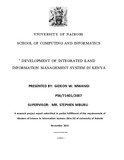Location
Our Vision is to be a world-class university committed to scholarly excellence.
Our Mission is to provide quality university education and training and to embody the aspirations of the Kenyan people and the global community through creation, preservation, integration, transmission and utilization of knowledge.
Core Values
In order to realize the above vision and mission, certain shared values shall be nurtured. There is great need for the University to be guided by the right values derived from the virtues and moral standards of the Kenyan and wider society.
Core Functions
Teaching and Learning: The university offers innovative , relevant and market driven academic programmes , both at undergraduate and postgraduate levels with inbuilt quality control systems the university also provides an environment and policy framework for undertaking high quality and relevant research
Members:
Resources
Displaying 116 - 120 of 298Use of Dry Land Tree Species (Prosopis juliflora) Seed Pods as Supplement Feed for Goats in the Arid and Semi Arid Lands of Kenya
Abstract: This study was conducted to determine the potential of incorporating Prosopis juliflora seed pods into typical dry land livestock production systems to minimize feed scarcity during the dry seasons and avoiding weight losses and poor performance. The study evaluated supplementation of weaner Galla goats with increasing amounts of Prosopis juliflora seedpods that is widely distributed in arid and semi arid areas of Kenya. This species is drought tolerant and with high productivity of seed pods whole year round.
Development of integrated land information management system in Kenya
Land is a key asset of any country. It is one of the factors of production which includes labour
and capital. It is critical for economic, social and political development of a country. There exists
a correlation between proper utilization of land and the economic advancement of a country and
its proper management can only be achieved if information on the said land is available. The
current globalization trend in the world, demand for efficient and effective land services requires
Different land use types in the semi-arid rangelands of Kenya influence soil properties
Rangelands in semi-arid Kenya have recently witnessed extensive land use changes. These changes
can mainly be attributed to increased livestock populations and the response of the increased human
population to both local and exogenous opportunities and constraints. This study was carried out in
Kibwezi district of Kenya mainly inhabited by agro-pastoralists. The main objective of this study was to
establish how different land use types influence soil properties in tropical semi-arid rangelands.
The Desert Margins Programme Approaches in Upscaling Best-Bet Technologies in Arid and Semi-arid Lands in Kenya
Kenya’s land surface is primarily arid and semi-arid lands (ASALs) which account for 84% of the total land area. The Desert Margins Programme (DMP) in Kenya has made some contribution to understanding which technology options have potential in reducing land degradation in marginal areas and conserving biodiversity through demonstrations, testing of the most promising natural resource management options, developing sustainable alternative livelihoods and policy guidelines, and replicating successful models.
A framework for national assessment of land degradation in the drylands
Land degradation is a gradual, negative environmental process that is accelerated by human activities. Its gradual nature allows degradation to
proceed unnoticed, thus reducing the likelihood of appropriate and timely control action. Presently, there are few practical frameworks to help
countries design national strategies and policies for its control. The study presented here developed a framework for the national assessment of
land degradation. This framework is envisaged to support governments in formulating policies on land degradation. It uses time-series remote






